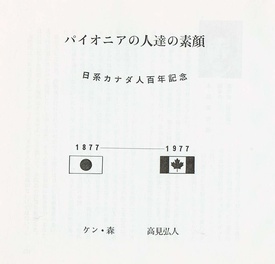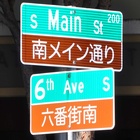The life of Nagano Manzo, the first Japanese immigrant to Canada, who was introduced in the previous column, is summarized in "The First Immigrant to Canada" (Osuzuyama Shobo), published in 1977.
This year marked the 100th anniversary of Manzo's arrival in Canada, and in addition to "The Story of Manzo," the book also contains a 98-page section titled "The True Faces of Pioneers: Commemorating 100 Years of Japanese-Canadian Relations," which, as the title suggests, introduces Japanese people (Japanese-Canadians) who were active across Japan and Canada.
Like the Manzo Monogatari, this book is believed to have been written by Mori Kenzo (Ken Mori) and Takami Hiroto. To repeat, Mori was born in Vancouver, Canada in 1914, and before the war he worked as a reporter for the Vancouver-based newspaper Tairiku Nippo, and after the war he served as editor-in-chief of the Japanese edition of The Guardian in Toronto. Takami was born in Miyazaki Prefecture in 1936, and stayed in Canada from 1965 to 1966, and has since been researching and studying the history of Japanese immigration.
When the pioneers first set foot in Canada, the Pacific coast of Canada was undeveloped and industry was underdeveloped. But that also meant that they could undertake some extraordinary endeavors. Some of them left Japan in search of wealth and ambition, and landed in Canada as stowaways.
Although each person's path is different, the lives of people who eventually distinguished themselves in various fields such as fisheries, agriculture, business, public service, and social welfare are also stories of adventure. Since this book seems to be quite difficult to obtain, below we introduce some profiles of pioneers who left unique achievements.
To try to realize the ideal
The first person to be introduced as an "unusual talent" is Oikawa Jinzaburo. Having been successful in clearing land near the Fraser River, where salmon fishing is thriving, Oikawa came up with a plan for a mass migration to create an ideal town for Japanese immigrants there. He returned to his hometown of Tome-gun, Miyagi Prefecture, and recruited travelers from the surrounding area. However, because this would violate the Mass Migration Restriction Act, he came up with a plan to build his own boat and stow away the group.
Oikawa himself entered Canada as a stowaway. He slipped onto a ship from Yokohama, blending in with the cargo workers. However, he failed and was deported. He tried to stow away three more times, but failed, and finally succeeded on his fourth attempt, reaching a fishing village called Stibston on the outskirts of Vancouver. Oikawa continued to secretly transport immigrants from Japan to Canada by ship.
The mass stowaway plot was to send 83 people on a ship called the Mizuyasu Maru. The ship bound for Canada in 1908 somehow managed to arrive, but the group was soon arrested. However, Jinzaburo's plan worked and they were able to enter the country. The details of this voyage and the turbulent life of Oikawa are detailed in the novel "Stowaway Mizuyasu Maru" by Nitta Jiro.
Tamura Shinkichi was said to be the leading figure in the Japanese business world before the war. He was so successful that in 1913 (Taisho 2), he built the four-story brick "Nichi-Canada Savings Company Building" in Vancouver's Japanese town.
Tamura was born in Osaka in 1863 (Bunkyu 3) as the eldest son of a samurai family in the Hosokawa clan of Kumamoto at a time when the winds of anti-foreigner sentiment were blowing through Japan, but with the start of the Meiji era, the samurai class fell into decline, and Tamura became an apprentice to a tea merchant in Kobe. At the age of 25, his ambition took him to Canada. He found work through an introduction from a pastor he met on board a ship, learned business, and eventually started a trading business and opened a Japanese art store in Vancouver. In 1907, he became the first Japanese person in the country to start a banking business, successfully building an office building.
At one point, his house was destroyed by fire, but he was lucky enough to escape because he had fire insurance. This contrasts with Nagano Manzo, who also lost his property to fire, but did not have insurance.
He eventually moved his base of operations to Kobe, traveling back and forth between the two countries to continue his trade.
Homma Tomekichi, originally from Chiba Prefecture, traveled to Canada in 1887 to work in salmon fishing. Amidst friction with white fishermen, he founded a Japanese Canadian fishing association. He later became a naturalized Canadian, but was denied the right to vote, so he began a legal struggle for the right to vote. After the war ended, Japanese Canadians were finally granted the right to vote in 1946.
Honma exhausted almost all of his personal assets in the lengthy trial, but his attitude was praised by Japanese Americans, and in 1977, 34 years after the lawsuit was filed, the name "Honma" was added to the name of a high school in Richmond in recognition of his contributions to improving the status of Japanese Americans.
USA, Mexico, Canada
Born in Niigata Prefecture in 1864, Ikeda Arichika came to Queen Charlotte Islands in British Columbia, Canada in 1906 and developed mining, becoming a pioneer.
He first worked on a plantation in California and organized a Japanese labor union. After returning to Japan, he planned to encourage Japanese immigrants to Mexico. When this plan did not come to fruition, he returned to California to work in agriculture.
However, when he heard that Alaska was experiencing a "gold rush," he headed to Alaska to develop mines, and with investment from Japan, he founded Canada Industrial Co., Ltd. However, the global recession later caused the development to stumble. Around this time, he explored Moresby Island (Canada) and discovered high-quality copper ore in a cove on the southern tip of the island, which was later named "Ikeda Bay." Later, in 1926, he invented a hanging oyster farming method and obtained a Canadian patent for it.
He was a pioneer with a knack for putting ideas into practice, but was ultimately unlucky in that very few of his ideas were successful.
Also attempting to pioneer in the Alaska area was Aikawa Noga, born in Gunma Prefecture in 1866. After landing in San Francisco, he moved to Seattle, raised funds and set off on an expedition to Alaska. He then arranged for Japanese workers to work at a lumber mill northwest of Vancouver for free. He cultivated the land himself and ran a farm and fishery company, but eventually returned to Japan.
The book, titled "Wacky in Mexico," introduces Junichi Haruhara, a native of Nagano Prefecture. In 1910, when a revolution broke out in Mexico to overthrow the dictatorship, Haruhara traveled to Mexico. After moving from one local city to another, he worked as a farm assistant.
One day, he encountered a military training session by the government army and ended up teaching them how to train the Japanese army. As a result, he was given a free pass by the government army and used it to travel around Mexico on a military train. However, when the government army was defeated, he felt that he was in danger of being shot by the revolutionary army because he had a free pass, so he escaped to Cuba.
After working there for a while, he re-entered Mexico, and from there he sneaked into the U.S. After working in several places, he went north and arrived in Vancouver, Canada. He eventually married a Japanese wife, had five sons and one daughter, and worked as a gardener.
Born in Hikone, Shiga Prefecture, Masajiro Miyazaki was summoned by his father to Canada at the age of 13, but his father went out to fish for salmon and never returned. He worked hard to get a good education, working as a maid in a white household while attending school, and graduated from the University of British Columbia in 1925. He then went to America to study medicine, and opened a practice as a doctor after returning to Canada. He gained the trust of his hometown, Lillooet, through his medical practice, and became the first Japanese-Canadian to become a town councillor.
Yasutaro Yamaya, a native of Toyohama Town in Hiroshima Prefecture, moved from Seattle to Canada as an agricultural pioneer and worked in strawberry cultivation. In 1958 he founded Nipponia Home, the first nursing home for Japanese people in Canada.
In addition to these, nearly 50 people, including second and third generation immigrants, appear in the book. It seems that the author spoke to some of these people directly. Unfortunately, it is not stated what sources the book was based on. However, the struggles of early immigrants to Canada, similar to their adventures, are vividly conveyed throughout the book. (Titles omitted)
© 2023 Ryusuke Kawai







